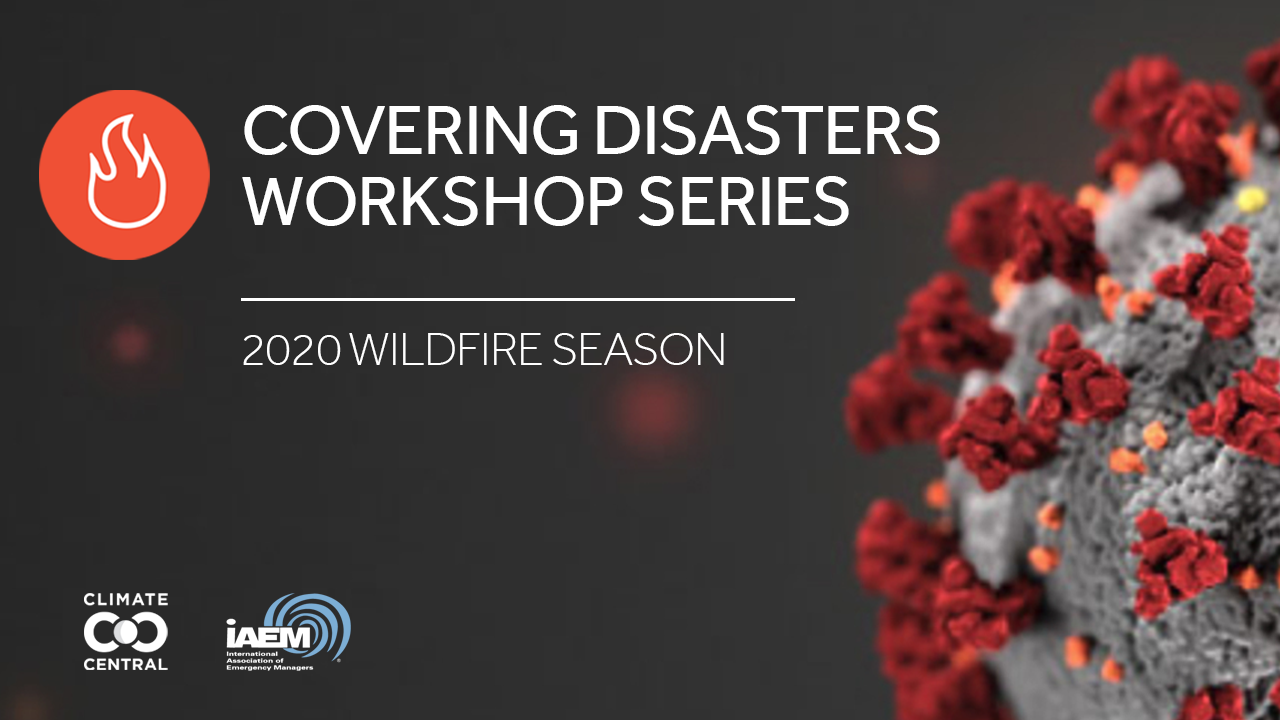JUMP TO:
KEY POINTS
Climate Central and the International Association of Emergency Managers (IAEM) held an online workshop on May 14, 2020, to prepare journalists and meteorologists for reporting on local emergency planning efforts during wildfires, with particular needs during the pandemic. Main points included:
Human-caused climate change is a contributing factor to the increasing size and intensity of western U.S. wildfires, along with forest management and urban growth into natural areas.
Outlook for the 2020 wildfire season:
Severe to extreme drought continues to be widespread in coastal portions of Oregon and Northern California (Portland to the Bay Area).
Moderate to severe drought is found across much of southern Colorado, northern Nevada, central Utah, and interior parts of northern California.
Over the past 3 years, temperatures have been 1-3°F above the long-term average in most of the West (exceptions are Montana and Wyoming).
Emergency planners and medical professionals are considering ways to keep fire suppression crews safe and practice social distancing during training and on the fire line, including alternatives to large fire camps.
Social distancing will make evacuations and evacuation centers more difficult to manage this year. Reporters may have more difficulty accessing survivors using traditional reporting techniques, and it will be harder to conduct interviews with officials near firefighting operations.
Training, prescribed burns, community meetings and other preparations for wildfire seasons have been limited this year because of COVID. Public information officers for agencies that respond to wildfires can describe local impacts on wildfire readiness for reporters, and on changes to firefighting techniques due to COVID protocols.
Wildfire smoke creates public health risks, and it is expected to amplify health risks from COVID this year. Outdoor workers are at greatest risk. Experts recommend wearing n99 masks to reduce risks from smoke pollution, though cloth and other alternatives can provide some protection from both smoke and COVID transmission.
Americans are suffering mental health impacts from the effects of the coronavirus, and wildfire disasters also hurt mental health. Local nurses and other frontline health workers could describe effects of these dual disasters on community wellbeing for reporters.
VIEW RECORDING OF MAY 14 2020 WORKSHOP
Back to Top
CLIMATE CENTRAL DATA & GRAPHICS ON CLIMATE AND WILDFIRES
Hotter Years, More Fires
Wildfires & Air Quality
Australian Fires and Climate Change
Wildfire Smoke Waves
Back to Top
RESOURCES FOR COVERING WILDFIRES
National Significant Wildland Fire Potential Outlook produced by the National Interagency Fire Center (NIFC) in Boise, Idaho.
North American Seasonal Fire Assessment and Outlook
Sci-Line has a fact sheet and experts ready to talk about wildfires and Climate Signals has materials on climate change and wildfires.
The National Interagency FIre Center has overseen the drafting of plans for nine geographic regions to help guide effective wildfire responses during the COVID pandemic
Firewise USA®is a voluntary program that provides a framework to help neighbors get organized, find direction, and take action to increase the ignition resistance of their homes and community.
The U.S. Drought Monitor map is released every Thursday, showing parts of the U.S. that are in varying levels of drought, from abnormally dry to exceptional.
AirNow, a partnership of multiple government agencies has a number of publications on wildfire smoke and air quality, and a wildfire and smoke tracking map.
Planning for Wildfire: Tips for creating 360-character Wireless Emergency Alert templates
Cal Fire keeps summaries and statistics on wildfires in California. It also publishes highly specific informational summaries called Green Sheets for some fires:
NBC Bay Area’s Rob Mayeda shares the wildfire slides he used for briefing his local news managers, titled California Climate: Broadcasters Perspective on Fire Weather.
Back to Top
ARTICLES ON COVID AND WILDFIRES
How Can California Fight Wildfires in the Middle of a Pandemic? In a Few Months, We'll Likely Find Out By Danielle Venton, KQED (California), April 20
Protecting the first responders, By Ryan Pfeil, Mail Tribune (Oregon), April 3
Pandemic And Wildfire: California Is Preparing For A Crisis Within A Crisis By Ezra David Romero, Capital Public Radio (California), April 15
Red Cross Overhauls Evacuation Shelter Guidelines Because of Coronavirus Pandemic By Ron Brackett, The Weather Channel, March 24
Marin firefighters face dual burden of virus, fire season By Matthew Pera, Marin Independent Journal (California), April 5
COVID-19 & wildland fire: Retired fire chief throws a warning flag By Linda Willing, FireRescue1, April 9
Back to Top
PANEL: NATIONAL AND REGIONAL EXPERTS CONTACT INFORMATION
Mike Gavin, Senior Planner for Synergy Disaster Recovery, former Emergency Manager for the City of Fort Collins, Colo. (ConferenceChair@iaem.com)
Daphne Stannard, Lecturer, San Francisco State University School of Nursing (dstannard@sfsu.edu)
S.Y. Simon Wang, Professor of Climate, Utah State University (simon.wang@usu.edu)
Darren Clabo, South Dakota State Fire Meteorologist, Incident Meteorologist (IMET) (darren.clabo@sdsmt.edu)
Monica Woods, Chief Meteorologist, KXTV (ABC) Sacramento, Calif. (mwoods@abc10.com)
Rob Mayeda, Meteorologist, KNTV (NBC) San Francisco Bay Area (rob.mayeda@nbcuni.com)
Danielle Venton, science reporter at KQED, San Francisco Bay Area (dventon@kqed.org)
Ryan Pfeil, Mail Tribune Web Editor, Medford, Ore. (rpfeil@rosebudmedia.com)
Back to Top
